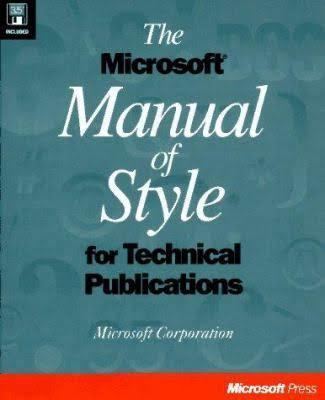Originally published 1995 | ||
 | ||
Similar The Business Style Han, The New York Times Manual of, The Gregg Reference Manual, Hart's Rules, Managing your document | ||
The Microsoft Manual of Style: Your Everyday Guide to Usage, Terminology, and Style for Professional Technical Communications (MSTP), in former editions the Microsoft Manual of Style for Technical Publications, is a style guide published by Microsoft. The fourth edition, ISBN 0-7356-4871-9, was published on January 15, 2012. Microsoft employees and partners can also access a Microsoft Compressed HTML Help (CHM) version of the MSTP.
Contents
History
Purpose
Like any style guide, the MSTP establishes standards and serves as a reference for writers. The MSTP has the specific purpose of guiding technical writers, editors, and content managers working with Microsoft products. While the manual in some parts focuses on usage particular to these products, the guide also serves as a general tool for technical writers. Content ranges from specific instructions for naming particular elements of specific programs to general rules of grammar.
Contents
The MSTP is divided into two parts, preceded by a foreword and introduction.
Part 1 is entitled General Topics and is sub-divided into the following 11 chapters:
- Content for the web: Defines parameters for all types of web content, including web, video, blog, international considerations and accessibility and legal considerations.
- Microsoft style and voice: Basic principles and style guide.
- Content for a worldwide audience: Provides instructions for ensuring that documents will be understood throughout the world by avoiding local references and making texts easy to translate.
- Accessible Content: Talks about accessibility in all areas including design, graphics and text; refers to acceptable terminology.
- The user interface: Provides standardized names for elements of the Microsoft user interface.
- Procedures and technical content: Provides guidelines for consistent formatting of procedures and other technical content to help users find important information quickly and efficiently
- Practical issues of style: Points out common problems ranging from capitalization to the formatting of style elements such as dates, numbers, and measurements.
- Grammar: Contains sections on the general usage of verbs and nouns.
- Punctuation: Contains information about using punctuation.
- Indexes and keywords: Provides guidelines for indexing and/or attributing content to ensure that it is discoverable for users.
- Acronyms and other abbreviations: Provides guidelines on consistent use of acronyms and abbreviations, including how and when to use them to avoid confusion. It also contains a list of acronyms and abbreviations.
Part 2 is an alphabetically-arranged Usage Dictionary of terms commonly used in technical writing.
